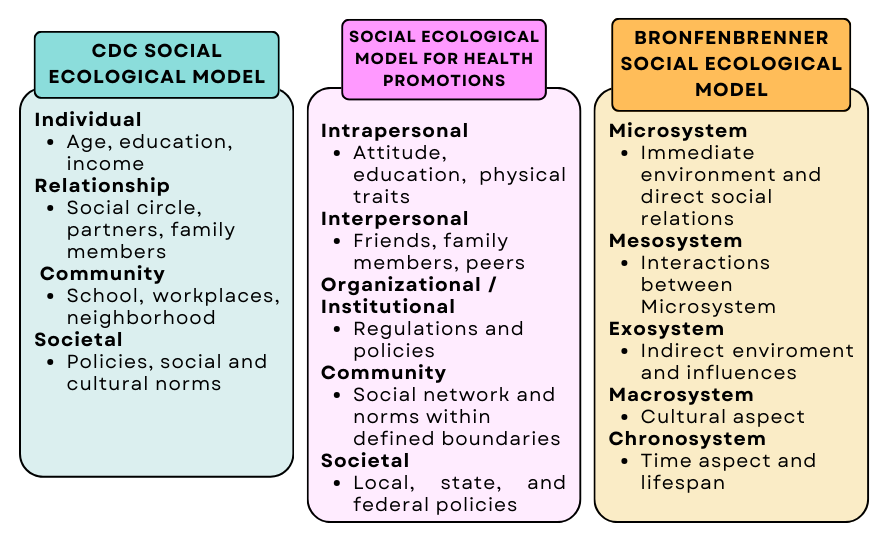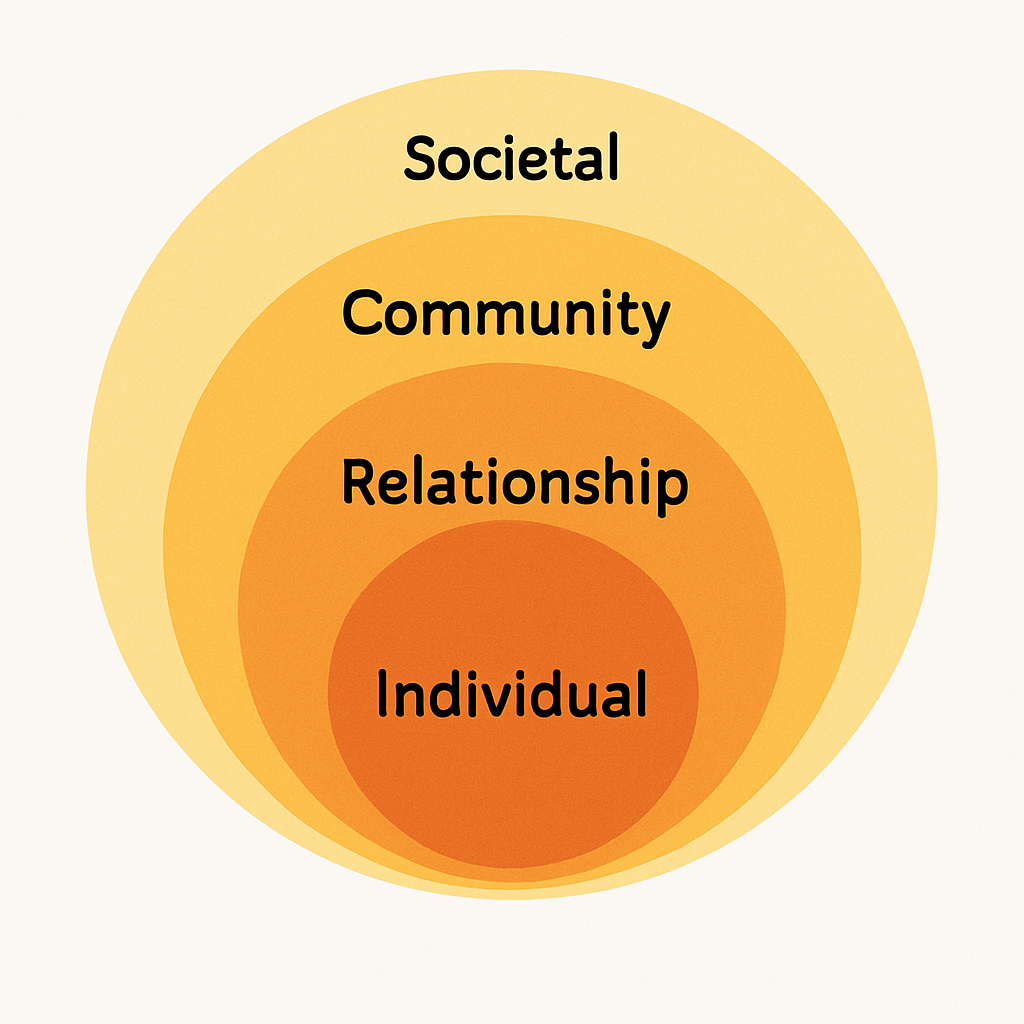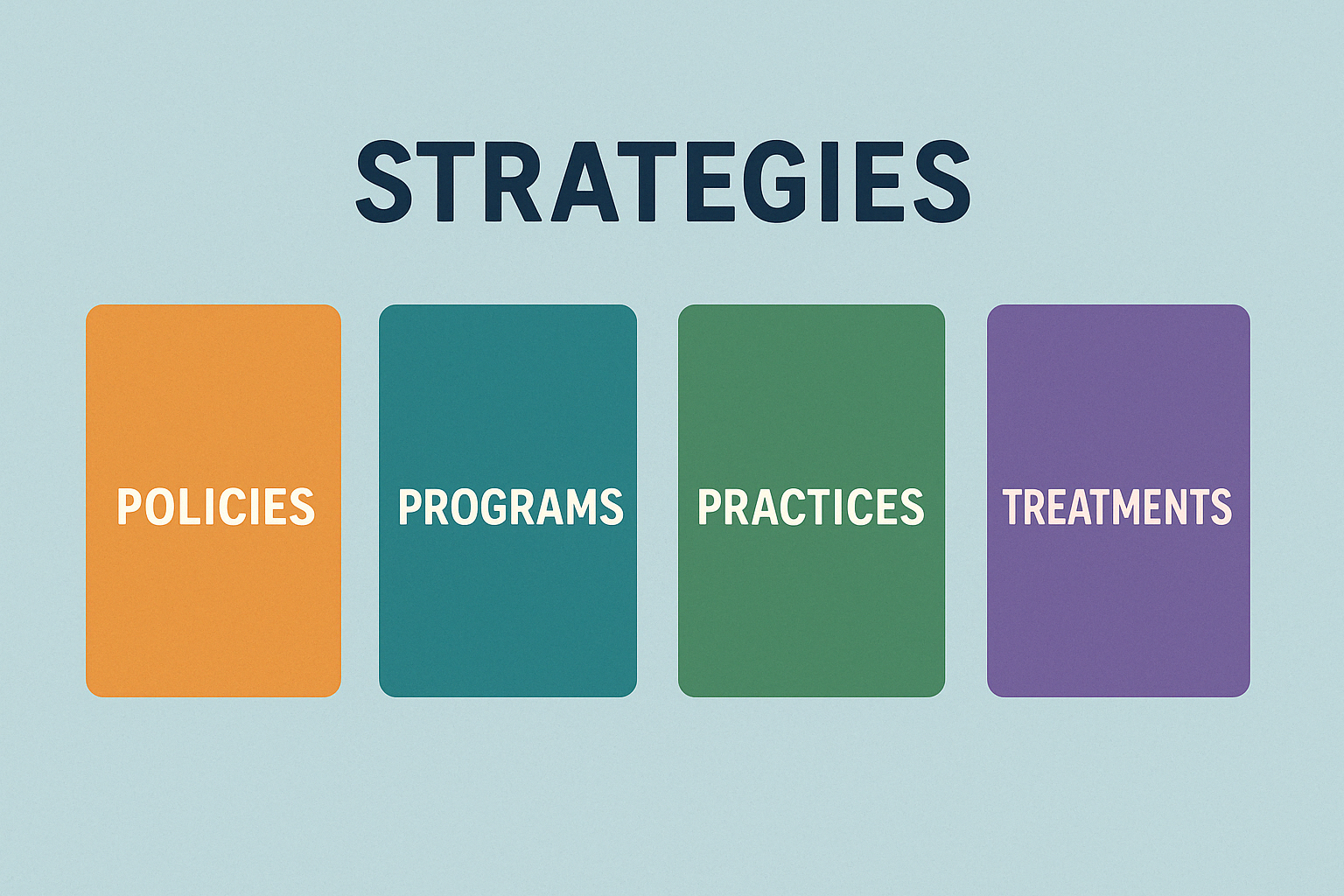2 Understanding the Layers of Influence and Health Challenges
Melissa Contreras
Picture this: a child growing up in a world where the odds are stacked against them. A world where they face abuse from their parents, go hungry for days, or are engulfed in a violent environment, a traumatic perception of what they believe is normal. This scenario sounds like something out of a movie, and many children do not experience these unimaginable events. Unfortunately, some children live with one or more of these tragedies. The National Academy of Sciences (2024) reported that the United States ranks 36 out of 38 among developed countries for children’s physical and mental health and academic and social skills. The absence or presence of disease should not be the only measurement for a child’s well-being, but health advocates should look for as many options as possible to assist these children in improving their quality of life (National Academy of Science, 2024). The social ecological model (SEM) uses a collaborative approach to address the many health challenges faced by children.
The social ecological model acknowledges the complexity of an individual’s social life as they exist within each level, constantly living out new experiences that affect their health (Garmon, 2021). Each SEM level focuses on a specific internal or external aspect that can hinder or improve an individual’s health behavior.
Based on Figure 1, researchers have created several variations of this collaborative model, including the Centers for Disease Control and Prevention’s social-ecological model, the ecological model of health behavior, and Urie Bronfenbrenner’s ecological theory. Each model aims to explain human behavior, but through different perspectives and levels of influence (Schneider, 2021). Bronfenbrenner’s ecological model emphasizes a variety of systems that directly and indirectly influence human development. The social ecological model of health behavior and the CDC social-ecological model are similar in intent. The difference between the two is that the ecological model of health distinguishes where individuals learn and work (organizational and institutional level) instead of having all community factors in one level. While the CDC’s version of SEM highlights preventing violence by analyzing risk factors and creating preventative measures to minimize negative developmental outcomes, the layers can be applied to any health issue (Centers for Disease Control and Prevention, 2022).
Figure 1.

The CDC Social-Ecological Model

The CDC’s SEM framework explores multiple levels, ranging from personal to environmental factors, influencing an individual’s behavior and health (Centers for Disease Control and Prevention, 2024). These levels include individual, relationship, community, and societal. This model emphasizes the idea of an interdependent system that plays a crucial role in all well-being outcomes (The Social Ecological Model, n.d.)
- The individual level analyzes personal factors like age, education, attitude, and behavior. These influences can alter attitudes and choices, resulting in positive and negative health outcomes.
- The relationship level examines an individual’s social interactions, which may include family, friends, and peers who significant influence on an individual’s health choices. This inner circle can alter perceptions to sway health behaviors and experiences.
- The community level includes schools, workplaces, clubs, and other social organizations that may create social norms. Many community resources are delivered by people outside an individual’s inner circle and supported by local and national organizations.
- The societal level explores government policies, government services, institutional standards, and funding capabilities. Policy and funding can influence an individual’s decision to engage in a health behavior.
The CDC’s SEM can be used to understand all possible factors influencing human development and behavior, as well as to form and apply them. For child health advocates, child health issues are complex, especially as they relate to family and cultural dynamics. Advocates look for interventions to help all children, but sometimes, special circumstances put some children more at risk. When children suffer from adverse childhood experiences (ACEs), it can impact long-term health outcomes.
Adverse Childhood Experiences (ACEs)
Adverse childhood experiences are known as traumatic experiences that may impact a child’s development. The ACE questionnaire asked adults 10 questions about their childhood experiences regarding household dysfunction: parental separation, incidents of domestic violence, substance abuse, mental illness, and criminal behavior; abuse (psychological, physical, and emotional); and neglect (physical and emotional) (Webster, 2022). All these circumstances can lead to toxic stress, which impacts various body systems’ function. Since brain connections form quickly in early childhood, their experiences strongly affect future health and growth.
An individual’s number of exposures to ACEs can influence decision-making. The more frequently a child is exposed to adverse experiences, the greater the likelihood that they engage in risky behavior (Webster, 2022). Some risky behaviors include alcoholism, drug use, depression, and suicide attempts (CDC, 2024 October). Children who scored zero or very low ACE scores were less likely to experience health difficulties or developmental issues (Webster, 2022). Being aware of the impact of ACEs, what they consist of, and the future health consequences can help create interventions aimed at preventing or limiting the negative developmental impact on children.
What makes a child “at-risk”
The term “at-risk” refers to an individual with a higher probability of having poor future outcomes (Child Trends, 2006). Individuals may be considered “at-risk” due to personal factors like trauma or disability, family conditions such as poverty or single parenthood, or environmental influences like unsafe neighborhoods. Although “at-risk” is widely used to describe individuals exposed to many risk factors, it’s important to acknowledge that it may contribute to the stigmatization of certain groups.
In this book, we do not intend to label any child as “at-risk”. We understand everyone has different life experiences. However, some circumstances (e.g., migration, homelessness, language barriers, financial and environmental circumstances, and disabilities) may increase the likelihood of barriers and challenges to optimal health results. We recognize those challenges and strive to share solutions for decreasing risk.
Promoting children’s health through SEM strategies

The SEM allows for multiple levels of intervention and prevention to deal with complex problems that increase risk factors for children and their families. By recognizing and addressing factors that would increase an ACE score, public health professionals can work together to decrease negative health outcomes. ACEs have been proven to lead to multiple health consequences and be a strong indicator of future success (Webster, 2022).
This book utilizes the CDC’s SEM to investigate the outcomes of various health challenges on children while also providing evidence-based interventions and solutions. The authors intend to provide ideas and resources for anyone who works with or wants to support children with their health struggles.
References
Centers for Disease Control and Prevention. (2021, April). About the CDC-Kaiser ACE study. https://www.cdc.gov/violenceprevention/aces/about.html
Centers for Disease Control and Prevention. (2024). About violence prevention. https://www.cdc.gov/violence-prevention/about/?CDC_AAref_Val=https://www.cdc.gov/violenceprevention/about/social-ecologicalmodel.html
Child Trends. (2006). Definition of the term “at risk”. https://cms.childtrends.org/wp-content/uploads/2006/01/DefiningAtRisk1.pdf
Garmon J. (2021). There are layers to this: a social ecological examination of social relationships and health. Rutgers University Libraries. https://doi.org/doi:10.7282/t3-vayh-g126
National Academy of Science. (2024). Children in the United States: Demographics, health, and wellbeing. In Launching Lifelong Health by Improving Health Care for Children, Youth, and Families. National Academies Press. https://www.ncbi.nlm.nih.gov/books/NBK610731/
Schneider, M.J. (2021). Introduction to public health. (6th ed). Jones and Bartlett. 199-200.
Webster E. M. (2022). The impact of adverse childhood experiences on health and development in young children. Global Pediatric Health, 9. https://doi.org/10.1177/2333794X221078708
the informal rules that guide behavior in groups and societies

